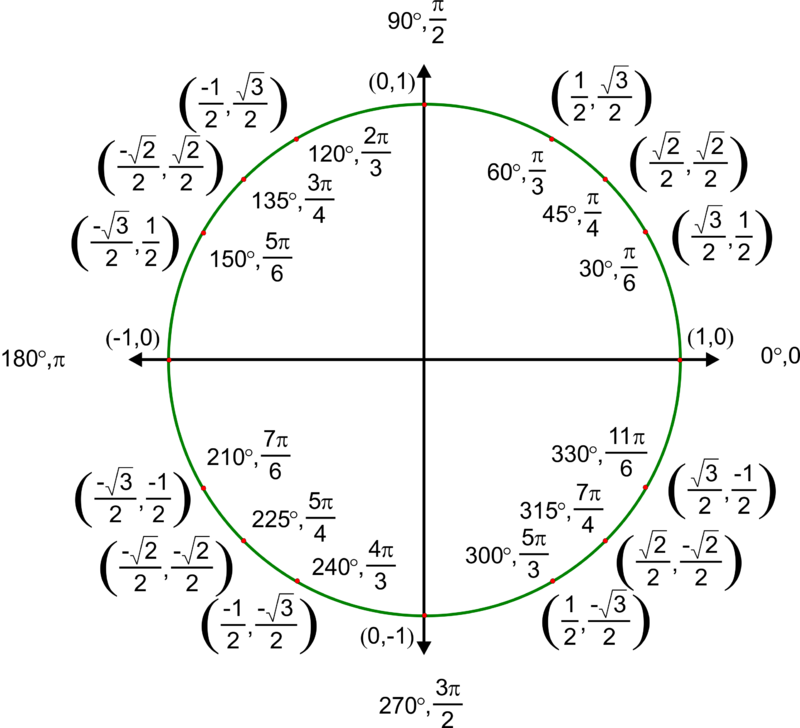Learning Outcomes
- Complete a table values with solutions to an equation
- Evaluate trigonometric functions at specific angle measures
In the Vector Fields section, we will be introduced to vector fields and how they can be used to model physical concepts such as gravitation and electromagnetism. Here we will review how to evaluate functions including trigonometric functions.
Complete a Table of Function Values
A table of values can be used to organize the y-values or function values that result from plugging specific x-values into a function’s equation.
Suppose we want to determine the various values of the equation [latex]f(x)=2x - 1[/latex] at certain values of x. We can begin by substituting a value for x into the equation and determining the resulting value of the function. The table below lists some values of x from –3 to 3 and the resulting function values.
| [latex]x[/latex] | [latex]f(x)=2x - 1[/latex] |
| [latex]-3[/latex] | [latex]f(-3)=2\left(-3\right)-1=-7[/latex] |
| [latex]-2[/latex] | [latex]f(-2)=2\left(-2\right)-1=-5[/latex] |
| [latex]-1[/latex] | [latex]f(-1)=2\left(-1\right)-1=-3[/latex] |
| [latex]0[/latex] | [latex]f(0)=2\left(0\right)-1=-1[/latex] |
| [latex]2[/latex] | [latex]f(2)=2\left(2\right)-1=3[/latex] |
| [latex]3[/latex] | [latex]f(3)=2\left(3\right)-1=5[/latex] |
We can look for trends among our function values by looking at the table. For example, in this case, as x-values increase, so do the y-values. Also, it seems reasonable to assume, based on the table, an x-value of 1 would result in a function value of 1. You can verify this for yourself by plugging 1 into [latex]f(x)=2x - 1[/latex].
Example: Completing a table of function values
Create a table of function values for [latex]f(x)=-x+2[/latex]. Use various integers from -5 to 5 as the x-values you plug into the function.
Try It
Try It
Evaluate Trigonometric Functions
(also in Module 1, Skills Review for Polar Coordinates)
The unit circle tells us the value of cosine and sine at any of the given angle measures seen below. The first coordinate in each ordered pair is the value of cosine at the given angle measure, while the second coordinate in each ordered pair is the value of sine at the given angle measure. You will learn that all trigonometric functions can be written in terms of sine and cosine. Thus, if you can evaluate sine and cosine at various angle values, you can also evaluate the other trigonometric functions at various angle values. Take time to learn the [latex]\left(x,y\right)[/latex] coordinates of all of the major angles in the first quadrant of the unit circle.
Remember, every angle in quadrant two, three, or four has a reference angle that lies in quadrant one. The quadrant of the original angle only affects the sign (positive or negative) of a trigonometric function’s value at a given angle.

A General Note: Evaluating Tangent, Secant, Cosecant, and Cotangent Functions
If [latex] \theta[/latex] is an angle measure, then, using the unit circle,
[latex]\begin{gathered}\tan \theta=\frac{sin \theta}{cos \theta}\\ \sec \theta=\frac{1}{cos \theta}\\ \csc t=\frac{1}{sin \theta}\\ \cot \theta=\frac{cos \theta}{sin \theta}\end{gathered}[/latex]
Example: Using the Unit Circle to Find the Value of Trigonometric Functions
Find [latex]\sin \theta,\cos \theta,\tan \theta,\sec \theta,\csc \theta[/latex], and [latex]\cot \theta[/latex] when [latex] \theta=\frac{\pi }{3}[/latex].
Try It
Below are the values of all six trigonometric functions evaluated at common angle measures from Quadrant I.
| Angle | [latex]0[/latex] | [latex]\frac{\pi }{6},\text{ or }{30}^{\circ}[/latex] | [latex]\frac{\pi }{4},\text{ or } {45}^{\circ }[/latex] | [latex]\frac{\pi }{3},\text{ or }{60}^{\circ }[/latex] | [latex]\frac{\pi }{2},\text{ or }{90}^{\circ }[/latex] |
| Cosine | 1 | [latex]\frac{\sqrt{3}}{2}[/latex] | [latex]\frac{\sqrt{2}}{2}[/latex] | [latex]\frac{1}{2}[/latex] | 0 |
| Sine | 0 | [latex]\frac{1}{2}[/latex] | [latex]\frac{\sqrt{2}}{2}[/latex] | [latex]\frac{\sqrt{3}}{2}[/latex] | 1 |
| Tangent | 0 | [latex]\frac{\sqrt{3}}{3}[/latex] | 1 | [latex]\sqrt{3}[/latex] | Undefined |
| Secant | 1 | [latex]\frac{2\sqrt{3}}{3}[/latex] | [latex]\sqrt{2}[/latex] | 2 | Undefined |
| Cosecant | Undefined | 2 | [latex]\sqrt{2}[/latex] | [latex]\frac{2\sqrt{3}}{3}[/latex] | 1 |
| Cotangent | Undefined | [latex]\sqrt{3}[/latex] | 1 | [latex]\frac{\sqrt{3}}{3}[/latex] | 0 |
